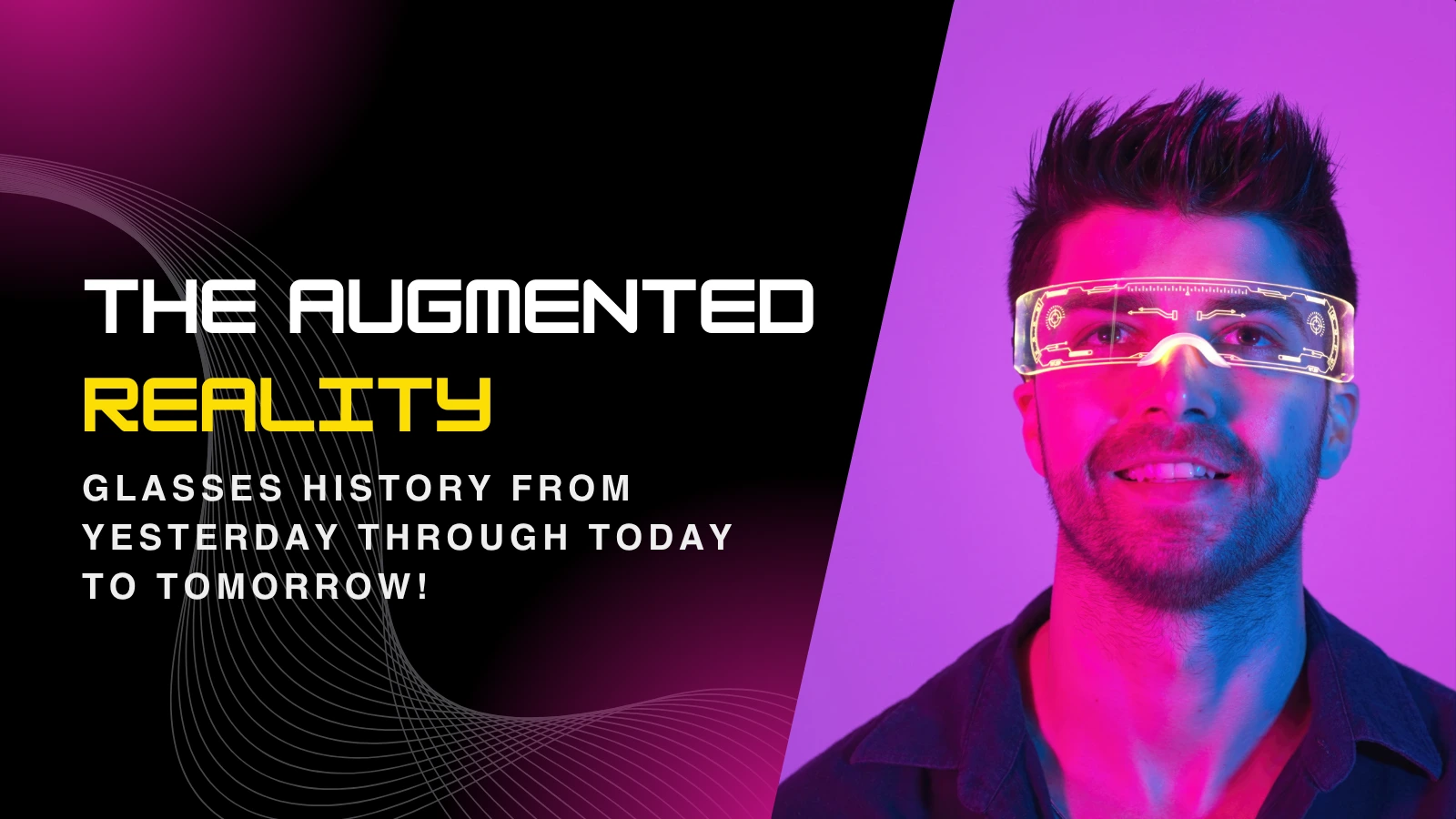The Augmented Reality Glasses History: From Yesterday Through Today to Tomorrow!
Published On: July 7, 2025

Augmented Reality (AR) glasses have evolved from clunky concepts to advanced, intelligent wearables to reshape our experience of the world. Nowhere near a staple of B-movie sci-fi, AR glasses have graduated to reality-based elements of industries as diverse as manufacturing and medicine to retail to entertainment.
But where did we originate? Where are we now? And where are we going? With this article, we uncover the fascinating history of AR glasses—selecting the thread of their evolution from original conceptual frameworks to uses today, and then to looking to tomorrow and forging the future with their promises.
The Past: From Military Concepts to Tech Concepts
Augmented reality glasses have a history much longer and deeper than most are aware. Superimposing digital info over the real world became an idea explored as far back as the 1960s.
1968: First of Its Kind, but Ceiling-Mounted Monster
The ancestor to today’s AR glasses can be traced to the work of computer scientist Ivan Sutherland and his construction of the Sword of Damocles, unveiled to the world in 1968. Hanging from the ceiling, this behemoth was the original head-mounted display (HMD) system. Simple and limited, but complete with possibility, the original HMD opened doors to decades of evolution. Not mobile, not portable, but an inspiration waiting to happen.
1980s–1990s: Military and Industry Applications
By the 1980s, ideas of augmented reality found their special use among the military and space exploration. With HUDs (their term, Head-Up Displays), pilots could see required information—speed, altitude, target—on their visors. Not experientially interactive as we use today, but an early form of overlaying digital with views of the real world.
During the decade of the 1990s, the Boeing Company became the prototype leader among uses of AR within industry. Engineers used headsets to examine wiring diagrams overlayed on airplane fuselages while assembling them. This reduced human error and accelerated efficiency—a glimpse into the practical possibilities of AR.
The 2000s: Tech Expansion and Consumer Interest
As computing power increased and shrinking continued, companies began exploring AR glasses for consumers. The imagination of blurring virtual and physical experience gained ground outside of military or specialized industry cliques.
2012: Google Glass — First Mass-Market Foray
Most famous early attempt at mass-market AR glasses came with Google Glass, unveiled in 2012. With an incredibly small display mounted precisely above the person’s right eye, Google Glass offered real-time data, speech-enabled interface, and camera function. Despite Google Glass actually delivering more of a “heads-up display” than true AR, Google Glass constituted an astronomical turning point.
Despite massive hype, Google Glass wouldn’t discover consumer acceptance due to problems of privacy (most especially with the built-in camera), limited ability, and a steep $1,500 cost. Ultimately, Google Glass turned focus to enterprise applications, where you can find it today, especially within industries like field service and logistics.
Other Breakthrough Experimenters
Other tech companies entered the fray around this same time. Vuzix and Epson, and especially Microsoft, experimented with various types of AR and intelligent glasses. These products were clumpier and mostly targeting enterprise customers but added to display technology, tracking, and interface innovation.
Present Day: Applications to Reality and Caveat Expanding Acceptance
As we reach the mid-2020s, AR glasses have undergone tremendous transformation. They are no longer niche devices nor are they science fiction. Big technology firms now build strong, advanced AR glasses with both enterprises and, incrementally, consumers as targets.
Microsoft HoloLens
HoloLens, launched in 2016 and later followed with HoloLens 2, took great leaps towards AR glasses. Mixed-reality headsets allow individuals to work with holograms using 3D space with hand gestures, gaze, and voice. While bulky and expensive, they have gained solid traction with architects, medical specialists, engineers, and the military for training.
Magic Leap
Magic Leap, another secretive firm once funded with billions, finally announced an AR headset, Magic Leap, in 2018. Despite hype and overpromise, Magic Leap 2, an upgraded model, refined comfort, optics, and content from developers. Magic Leap is gaining traction with healthcare, defence, and training uses.
Snap Spectacles & Meta’s Ray-Ban Stories
Towards the budget-end spectrum, Snap Inc. (Snapchat) introduced Spectacles to aid basic overlay AR and immersive views. Meanwhile, Ray-Ban Stories, jointly developed with Meta (previously Facebook), are intelligent glass frames equipped with built-in camera and voice commands. Far from full AR, they are incremental innovations towards integrated AR within consumer wearables.
Enterprise-Driven Innovation
Most innovation within AR glasses today comes from enterprises. Vuzix, RealWear, and Epson create devices which are rugged, voice-controlled, and ideal for field service, warehouses, and remote guidance. They are redesigning work processes with reduced downtime, enhanced protection, and remote guidance.
Challenges: Why AR Glasses Are Not Yet Popular
Despite progress, AR glasses have many challenges to overcome to achieve mass consumer use.
Hardware Hurdles: Balancing power, battery, heat, and beautiful look is proving difficult. Real AR requires robust processing and sensors within an ultra-small package.
Display Quality: Light-viewable, high-resolution displays not interfering with the physical world are hard to produce.
Privacy Concerns: Humans are apprehensive with devices with always-on cams and mics in open spaces.
Price: Most AR glasses are still too expensive, costing thousands of dollars, far beyond masses’ purchase power.
Lack of Adequate Use-Cases: For average consumers, there are not enough must-have AR use-cases required to provoke consumers to use glasses on a day-to-day basis.
Future: What’s on the Horizon for AR Glasses?
Despite today’s constrains, tomorrow’s AR glasses are very bright. With the next 5–10 years, here’s what we have to look forward to:
Light, Streamlined Designs
Advances in microdisplays, waveguides, and power cells will get AR glasses to look and feel like normal eyeglasses. Manufacturers are competing to create consumer-friendly wearables with flair and merit.
Apple’s long-rumored-over Apple Vision Glasses, to launch sometime preceding the late 2020s, are previewed to achieve usability and integration peaks. With their triumph, they have the capability to do to AR what the smartphone did to the cell phone.
AI-Driven Intelligence
Adding AI will make AR glasses very intelligent. Instead of only displaying information, upcoming glasses may:
Understand your context
Understand languages simultaneously
Give you personal fitness or medical insights
Call out things of interest based on your interests
Consider walking into a supermarket and your glasses guiding you to the best choice to munch on based on your nutritional requirements.
Edge Computing and 5G
Ultra-low latency with the assistance of edge computing and 5G will usher in more immersive AR experience without taxing on-board processors. This will boost responsiveness and allow for true-time collaboration over geographies.
Seamless Interaction with IoT and Smarter Worlds
AR glasses shall be the centerpieces of the Internet of Things (IoT) universes. From smart homes to internet-enabled factories, glasses shall create a principal interface to manage sensors, equipment, and environments with the use of simple speech or gesture-based directives.
Consumer-Focused Applications
New genres of AR apps shall emerge:
Gaming & Entertainment: Pokémon Go was only the appetizer. Buckle up for full AR gaming.
Fitness & Health: AR-guided workout, posture enhancement, or even biometric feedback.
Learning & Navigation: Step-by-step visual tutorials on DIY repairing, cooking, or city exploration.
Increased Accessibility
AR glasses shall greatly increase accessibility to persons with visual, hearing, or cognitive challenges. Real-time closed captioning, object recognition, and reminders could assist independent living and communication.
Conclusion: A Revolution Ahead of Us
Augmented reality glasses’ history is testament to human curiosity and thirst to move forward. From gigantic prototypes of the 1960s to today’s sophisticated mixed-world headgear and intelligent glasses, the journey has been remarkable—yet we have only gotten started.
As the gear becomes more advanced, cost comes down, and number of uses rises, AR glasses marketing shall likely become an integral part of our lifestyle, learning, work, and communication. They shall not only show the world to us—they shall help us to learn and transform the world.
Your glasses a decade hence may not only let you see better—they may let you see more.


